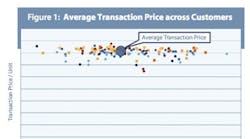Price is one of the most powerful levers available for manufacturers to proactively determine financial performance. Price affects competitive position, influences the number of units to be sold and is a critical factor in achieving an optimal product/margin mix. Pricing decisions for many manufacturers are executed daily in tens of thousand of transactions, and these decisions ultimately sum to a company's key financial performance metrics: revenue and profitability.
Company executives usually have a pretty quick answer to the question, "Do you know what customers are paying for your products?" They will rapidly produce a price list or average price statistics. But, is this really what customers are paying?
Average Price Versus Net Price
The old saying poking fun at statistics, "When you have one foot in boiling water and the other in ice water, on average you are comfortable," aptly describes the value of average price. However, most executives and managers rely on average price -- defined as sales revenue divided by units sold -- as a measure of what their companies actually charge customers for their products. In reality, average price does not come close to telling the whole story and is often far from the reality of what is happening with the business.
Why is average price such a misleading number? The first reason is the definition of price. At many companies, price is generally a pretty fuzzy term. In the end, the number that really matters is net price. Net price is the amount of money your company reaps from a transaction after the dust of rebates, bill-backs, accruals and discounts settles. Unfortunately, "net price" is generally very difficult to compute given that discounts and programs are often negotiated separately from product price decisions, and there is a complex interplay between all of these programs. In addition, the timing of the bill-backs and rebates that finally settle a transaction can often be quite far apart, making net price calculations a complicated accounting exercise.
Even if true "net price" is computed at the transaction level, average price does not tell the whole story. Average price misses variability or consistency of prices. In my experience, high levels of price inconsistency are the norm -- not the exception.
Across a large number of companies and a broad range of categories, there is often little consistency in transaction-level net pricing. This inconsistency results in a disturbing situation from a customer management and financial performance perspective. Figures 1 and 2 illustrate how average price and net price for the same products diverge significantly. The impact of such inconsistency is certainly felt in the bottom line of the business.
What are the reasons for this inconsistency in pricing? Beyond mistakes, typos, unintended overlaps in deals, unauthorized discounts, grand-fathered deals and exceptional prices that were done "just to get the business," there is one over-riding reason: choosing the price for a product or mix of products is very complex. While it's clear that pricing is vital to an organization's margins, most manufacturers still determine prices using some combination of ad-hoc analysis, spreadsheets and calculators.
Determining the Right Prices
So what are the "right" prices? The criteria for evaluating the "rightness" of prices are pretty clear:
- Are profit targets being met?
- Are prices responsive to changing competitive conditions for a company's products?
- Are manufacturing assets being optimally utilized?
- Are manufacturing assets generating the highest profit available per unit of capacity?
- In the end, is the business generating a reasonable return on capital employed?
Getting to the right prices is a more complex matter. At a minimum, factors that need to be considered include: past prices, market/competitive prices, demand elasticity, product costs, expected changes to product costs, target margins, and manufacturing capabilities/constraints. Rarely are all these factors considered simultaneously in pricing decisions today. Without a comprehensive means of determining and evaluating prices in a way that takes into account all of these complexities, pricing will be inefficient and margins will suffer.
Pricing as a Competitive Advantage
With the competitive bar being raised ever higher in these challenging times, the winning companies will be those that apply all of the tools available to them to make pricing decisions. At the end of the year, financial performance is achieved one transaction at a time. Leading manufacturers who learn to evaluate each and every transaction with company profitability squarely in mind will see gains in year-end corporate performance.
Well-documented research and numerous studies point to the significant margin improvements possible when companies make better pricing decisions. One of the most prominent of these studies was published in Harvard Business Review and indicated that a 1% improvement in price can drive an 11% improvement in operating margin.
Price and margin optimization software enables companies to make smarter pricing decisions. Using patented, comprehensive mathematical models to process thousands of variables, this technology allows customers to use price as a lever for adjusting supply and demand on a continual basis. With optimized price, supply utilization and product mix recommendations, manufacturers are better able to make the critical margin decisions they face every day.
Price and margin optimization software allows manufacturers to easily:
- Understand what customers really pay for products
- Improve margins even with volatile input costs
- Determine optimal deal prices
- Develop plans for best product mix and capacity utilization
- Increase sales and trade spend effectiveness
Charles Troyer is Chief Technology Officer at SignalDemand. SignalDemand provides manufacturers with on-demand software and services. Using patented, comprehensive mathematical models to process thousands of variables, SignalDemand's technology allows customers to adjust supply and demand on a continual basis. It works with companies such as Cargill, Farmland Foods and Hormel. http://www.signaldemand.com/





